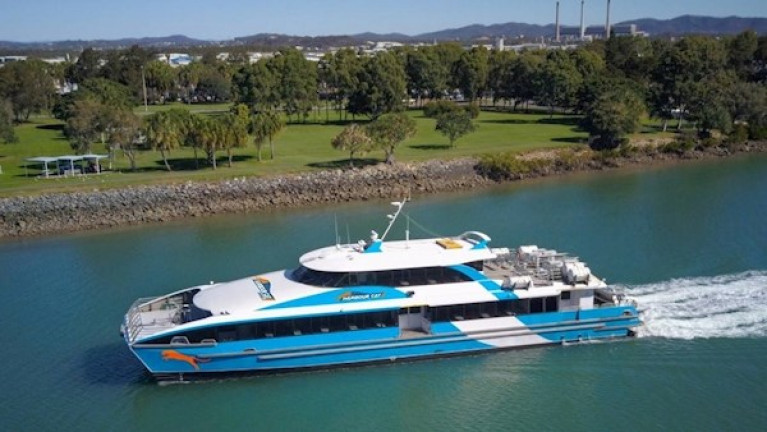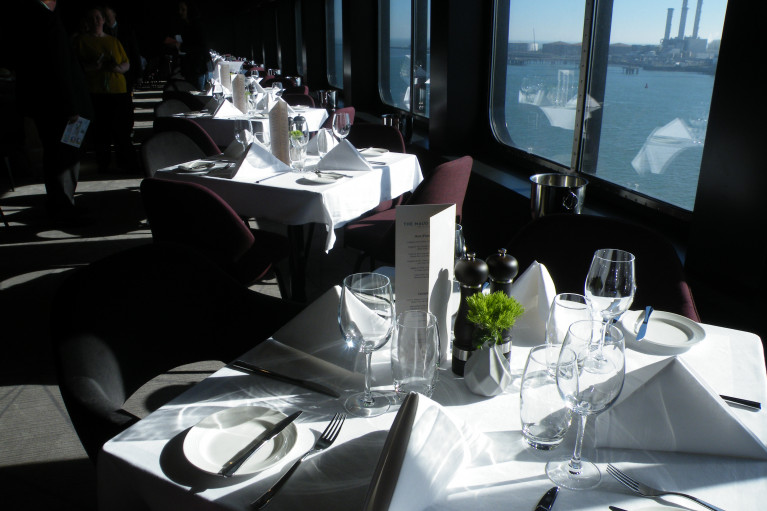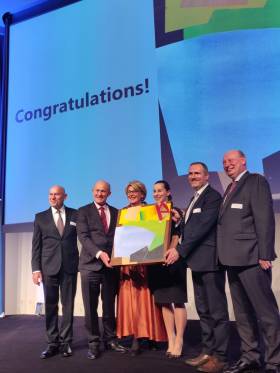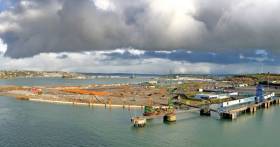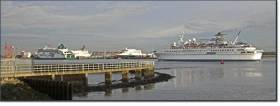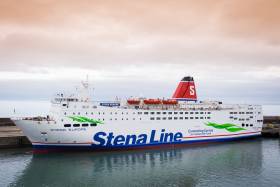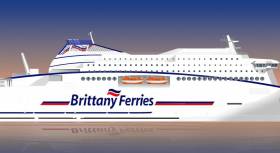Displaying items by tag: Ferry news
A €15m tourist and commuter ferry network plan proposed for Cork Harbour, which will create up to 70 jobs, are to be lodged with local authorities shortly.
A group of private investors, reports the Irish Examiner, are aiming to have the tourist ferry service operational by next year and the commuter service up and running in 2022.
The new service will serve communities all along the harbour shores, including Crosshaven, Aghada, Cobh, Monkstown, Passage West, and on up to Blackrock, the new Docklands, and onto the city quays.
There are even plans to have a docking location at the rear of Páirc Uí Chaoimh, to bring passengers to and from sporting and concert events.
Adian Coffey, who leads the investors, Harbour Cat Ferries, said they intend to build pontoons in those areas to serve passengers and to purchase four 35m-long Catamarans, Enviro-Cat 35s, which will bring people around the harbour.
He said it was their intention to purchase two for the tourist business and two to operate the commuter routes.
For more on this ferry development click here.
Irish Tourism Industry Demands VAT Cut
The tourism industry in Ireland has said it can deliver growth of 65% if the incoming government restores the 9% Vat rate.
The Irish Tourism Industry Confederation published its election manifesto today and said Brexit, weakened demand and increased costs of business have resulted in revenue falling by 1% in 2019 with regional Ireland hit hardest.
The confederation is made up of tourism businesses and stakeholders including Aer Lingus, B&B Ireland, Irish Ferries, the Restaurant Association of Ireland and the Vintner’s Federation of Ireland.
Along with a Vat reduction, the confederation said the cost of insurance must also be addressed.
For more on this story from BreakingNews.ie click here.
European Sea Ports Organisation (ESPO) Award Winner is the Port of Dover
This year's European Sea Ports Organisation (ESPO) Award winner is the Port of Dover in recognition of its successful strategy to reach out to the local community and to directly communicate with the port citizens.
Using social media as a new way of communicating and demonstrating a high level of transparency about operational achievements, future strategies and environmental challenges and performance is becoming increasingly important for European ports who can only function and further develop if they receive the licence to operate from the local citizens.
The ESPO Award was handed out on Wednesday by the Director-General of DG Move Henrik Hololei during a ceremony at the “Albert Hall” in Brussels.
Looking back at the selection process in this 11th edition of the ESPO Award, the Chairman of the Jury, Dimitrios Theologitis said: “The Jury was impressed by Port of Dover’s strategy which is centred around campaigns on all media, electronic and others, leaflets, consultations, forums, workshops, sports events. But the most important ingredient of this successful strategy is giving back to the community, be it financial participation in charities and community groups, making the installations available to the public for events, or foreseeing spaces and buildings open to the public”.
The Port of Dover won the 2019 Award for its project, “Transparen-SEA (Socially Engaged Accountability)”, which aims to create a comprehensive and meaningful programme of consultative and social community engagement events alongside the cultivation of an internal network of port ambassadors whose advocacy ultimately permeates back into the local community where many live. This was all supported with a social media overlay that connects directly with the community and reinforces the aims of the project.
The project has not just been focused on one particular aspect of engagement, it has been a wholesale immersion in the community and the community in the port. What is equally important is that the social media has not just been a faceless arm’s length engagement tool, but has been used to create the end result of much more face to face engagement so that the people of the port community and the people of the local community recognise each other, and do so as part of the same overall community, importantly all buying in to the same shared vision and giving everyone a sense of ownership of that process.
Richard Christian, Head of Policy and Communications, Port of Dover said "Having gone through such a rigorous selection process alongside many other great ports, to have been chosen as the winner is a fantastic achievement for the whole team at Dover. Our comprehensive and continuing programme of societal engagement is something of which we can be proud in setting the standard across Europe. Our thanks to ESPO and the judges for this great honour."
The ESPO Award 2019 saw four projects from Port of Dover, Dublin Port Company, Ports of Stockholm and Union des Ports de France (UPF) compete for the prize.
#portofCork - One or two ferry services, reports The Irish Times, could be run through the Port of Cork to the UK should a no-deal Brexit lead to congestion at Dublin Port, according to the executive of the southern port.
Brendan Keating, Port of Cork chief executive, said the port could handle a ferry service or two to the UK – most likely to Fishguard, Swansea or Bristol for eight to 12 weeks after a no-deal Brexit – but said the port would need more than €500,000 to make the necessary preparations, depending on traffic volumes.
“All we can do is plan for the worst scenario and, in that context, if a hard Brexit comes to pass we can step up to the plate and facilitate an additional service or two,” Mr Keating said.
Department of Transport briefing papers identify Rosslare Europort and the Port of Cork at Ringaskiddy to be used potentially to take roll-on, roll-off (RoRo) lorry traffic from Dublin Port, which handles more than 85 per cent of the country’s road freight, should checks in a no-deal scenario lead to a backlog.
For further reading on Contingency Plans click here.
#TravelAwards – At the Irish Travel Industry Awards held recently in Dublin, the winners in the Ferry and Cruise categories were presented in the historic surroundings of the Mansion House.
The annual awards are an initiative of the Irish Travel Agents Association (ITAA) with the support of Worldchoice and Travelsavers. The awards are the premier awards for suppliers and travel agents in Ireland.
Below are listed the winners from the Ferry & Cruise categories:
Best Ferry Company: Irish Ferries
Best General Cruise Company: Royal Caribbean International
Best Ultra Luxury Cruise Company: Silversea Cruises
Best Specialist Cruise Company: Uniworld River Cruises
Ship Strapline for Stena Europe A First for Irish Sea Ferry Fleet
#ShipStrapline - Stena Europe may be the oldest ferry in the operator’s Irish Sea fleet of seven ships, but the 1981 built vessel has emerged fresh from dry-docking as the first to sport a new livery strapline, writes Jehan Ashmore.
The ferry operating the Rosslare-Fishguard route now has large 30-foot ‘blue’ lettering emblazoned on the hull with the words: ‘Connecting Europe for a Sustainable Future’. Accompanying the strapline on either sides are overlapping waves painted in shades of ‘green’. The strapline is to reflect Stena Line’s commitment to becoming a more sustainable and environmentally friendly company, a key aspect of the company’s future business strategy.
The external livery work on Stena Europe was carried out during a refit at Harland & Wolff shipyard. The work in Belfast was managed by Stena Line’s group sister company, Northern Marine Ferries as part of an ongoing £7m fleet refit programme. A fleetmate, Stena Lagan is currently at H&W for a refit while off duty from the Belfast-Birkenhead (Liverpool) route. Taking her place is Stena Horizon which in turn has been displaced from Rosslare-Cherbourg service by relief ferry Stena Nordica, see related report.
Ian Davies, Stena Line’s Trade Director (Irish Sea South) commented: “We are delighted that one of our vessels has become the first Stena Line ship on the Irish Sea to promote our new company strapline which graphically reflects our increasing commitment to become a more sustainable and environmentally friendly company.
In addition to the exterior upgrades of the Stena Europe work was carried out on bow thrusters, rudders and main shaft seals under the water line. Additional upgrades applied to the galley, bar and crew accommodation.
To accommodate the increasing demand from the freight transport industry, Stena Line also increased the height to an area of the Stena Europe’s cargo deck.
The height clearance is 4.65m which is to handle all trailer height variations. This has allowed access to high top trailers, a key requirement of more freight customers operating between the UK and Ireland and for the company to expand the business in 2017.
Flagship to Fast Ferry Take Turns for Annual Overhaul
#Overhauls- Ulysses flagship of Irish Ferries departed today fresh from annual overhaul having dry-docked at Cammel Laird, Birkenhead on Merseyside, writes Jehan Ashmore.
From Birkenhead the 50,000 gross tonnage Ulysses the 1,875 passenger/ 1,342 car capacity giant proceeded in the early hours along the north Wales coast to Holyhead. The repositioning passage is understood to have almost taken seven hours with an arrival at Anglesey just after 08.00hrs.
Currently occupying a dry-dock of the Merseyside facility is that of Dublin-Holyhead fleetmate, high-speed craft HSC Jonathan Swift. The 800 passenger/200 cars fastferry is also undergoing routine maintenance work. Launched in 1999 as an Austal built Auto Express 86m fastcraft ferry in Fremantle Australia, the 5,000 tonnes catamaran is the only such type of vessel operating between Ireland and the UK.
For almost two decades the ‘Dublin Swift’ as she is marketed has been the workhorse of the Irish Sea operating on the 1 hour 49 minute crossing. Each crossing is at 40knots /80kph on the 60 nautical miles / 111 Kms route which totals annually to an impressive 162,000 Kms.
There is another fastcraft, Manannan but this ferry only operates between the Isle of Man and Liverpool and seasonal calls elsewhere to include Dublin Port.
Providing sailing coverage whilst Ulysses was off service and now that of Jonathan Swift fast is that of Isle of Inishmore which in recent weeks was transferred from Rosslare-Pembroke. The cruiseferry having taken the roster of Ulysses. This is set to change as Ulysses resumes on an afternoon crossing bound to Dublin, permitting Isle of Inishmore to also receive attention of annual overhaul.
Taking her place on the Rosslare-Pembroke service since late last year so to cover demands of seasonal capacity on the busy Dublin route, is Oscar Wilde which does not sail at this time of year to France. The cruiseferry however is to resume service with a crossings from the Wexford port to Cherbourg beginning in March.
Returning to the Dublin-Holyhead route which is also operated by ropax Epsilon. As previously reported on Afloat, the chartered Italian flagged ferry made her first sailing of 2017 on the weekend round trip Dublin-Cherbourg connection.
Epsilon Enters Fifth Year of Service of Five Strong Ferry Fleet
#FrenchFerry - The first sailing in 2017 of Epsilon on the Ireland-France route of Dublin-Cherbourg operated by Irish Ferries took place yesterday, writes Jehan Ashmore.
Under overcast skies yet flat calm seas, Epsilon departed Dublin Bay in mid-afternoon where the only vessel at anchorage was asphalt/bitumen tanker Iver Ability. The 106m ship is at the centre of cargo ‘issues’ following an investigation of a fire due to a reaction on board during tranport of bitumen into Dublin Port last summer and has since remained at anchor.
The New Year marks as the fifth year of the chartered Italia flagged Epsilon under Irish Ferries operations but based on ‘economy’ class service on the French route. Three months into service the prefix of the ropax name, Cartour Epsilon was dropped. This was to remove the connection with previous operator, Caronte & Tourist SPA, Italy from where she served routes to Sicily.
At the time of posting Epsilon is docked in Cherbourg having completed the 17 hour 30 minute crossing from Dublin Port with an arrival this morning. As of this afternoon in the Normandy port is where rival Stena Line’s ropax, Stena Horizon departed and is bound for Rosslare tomorrow morning. Also in port is Brittany Ferries Barfleur one of several in the fleet serving on the English Channel in this context Cherbourg-Poole.
In addition the ropax 500 passenger/500 car capacity Epsilon serves during the week Dublin-Holyhead crossings and is due to dock in Dublin tomorrow morning before resuming such duties. Epsilon supports Walsh route regulars the fastcraft Jonathan Swift and flagship Ulysses currently off service, see report on Cammell Laird.
Taking the roster of Ulysses is routine Rosslare-Pembroke ferry Isle of Inishmore which in turn has been replaced on the southern corridor by Oscar Wilde. The cruiseferry during the winter does not operate out of Rosslare routes to France but is scheduled to resume service at the start of March, albeit only serving Cherbourg. The seasonal-only shorter route to Roscoff resuming in May.
Epsilon (E) is the name given to the fifth letter of the Greek alphabet which is apt given the ropax is also the firth vessel to join the current Irish Ferries fleet serving the UK and France. The flagship Ulysses resembles the appearance of a €144m cruiseferry on order to Flensburger Schiffbau (FSG) scheduled for delivery in May 2018. Emissions 'scrubber' technology is not included in the contract price.
The 50,000 gross tonnage cruiseferry will accommodate 1,885 passengers and crew. The newbuild will have 435 cabins, 2,800 lane metres of freight vehicle space with room for 165 freight vehicles and an additional dedicated car deck with capacity for 300 passenger cars.
According to Irish Continental Group (ICG), parent company of Irish Ferries, the cruiseferry will be designed to best meet the operational seasonality of their business. ICG commented that it is likely that the new cruiseferry will be introduced on routes served by Epsilon.
Brittany Ferries Newbuild Prepares Way for LNG Powered Era
#NewLNGbuild - Irish Continental Group (ICG) parent company of Irish Ferries, in May 2016 announced an order for a new cruiseferry in a German shipyard in which Brittany Ferries have also signed a letter of intent with the same yard to construct a newbuild.
Afloat adds the Irish order to Flensburger Schiffbau (FSG) scheduled for delivery in May 2018 notably differs to that of the French ferry given this newbuild will be powered by liquefied natural gas (LNG). The 42,000 gross tonnage ferry will operate on the English Channel but the Breton based company has a seasonal service to Ireland as referred below.
The announcement re-states Brittany Ferries' commitment to reduce the environmental impact of its operations by embracing new technologies. It follows the completion of a £65m investment in emission-reducing 'scrubber' systems retrospectively fitted to the flagship Pont-Aven (Cork-Roscoff: seasonal) and five other cruise ferries in the company's ten-ship fleet.
According to Brittany Ferries, the newbuild will be one of the cleanest, most environmentally-friendly ships to operate in UK waters because LNG emits less carbon dioxide during combustion than marine fuel oil and burns with no smoke. In addition it is free of sulphur and is very low in nitrogen oxide emissions.
Christophe Mathieu, CEO, Brittany Ferries said: "The signing of this letter of intent with the Flensburger shipyard is a concrete step towards the construction of a new generation of Brittany Ferries ships. Despite Brexit, we remain confident in our ability to continue to grow and modernise our route network, serving both tourism and trade in the regions of western Europe."
More than four in five people travelling on the French company's ships are British and more than 2.4 million passengers were carried in 2016. A final contract for the 1,680 passenger and 257 cabin vessel is expected to be signed in spring 2017, following which construction will start.
The new ship is expected to launch in 2019 on the Portsmouth-Caen route which offers three daily return sailings. It will operate in tandem with popular cruise ferry, Mont St Michel, launched in 2002.
Nomadic Nordica’s Return for Stena On Irish Sea Relief Duties
#DryDockings – A former Irish Sea ferry Stena Nordica that served the busy Dublin-Holyhead service has returned albeit deputising as routine ships undergo annual winter dry-docking, writes Jehan Ashmore.
Stena Nordica (2000/24,206grt) as relief ferry for the operator’s Irish Sea fleet is however not currently covering in on the central corridor but is operating on the southern corridor having taken up Rosslare-Fishguard sailings. This allowed the routine Ireland-Wales route ferry, Stena Europe to be drydocked at Harland & Wolff, Belfast having arrived at the facility yesterday.
In order for the change of ferries on the St. Georges Channel service, Stena Nordica departed Dublin Port on Tuesday bound for Rosslare. The ropax, however previously made a far longer repositioning voyage to reach Ireland from Ventspils, Lithuania.
The Stena Nordica had been in the Mediterranean Sea this summer on charter to Italian operator Grandi Navi Veloce (GNV). During the charter only the letters of that company painted in blue appeared across the superstructure and hull of an otherwise all-white livery, except for logo on the funnel.
The voyage from Latvia, was the first return to the Baltic Sea since Stena Nordica was deployed to serve Stena’s Scandinavian operations around a decade ago. The ropax was transferred on the Dublin-Holyhead route in 2008. Larger tonnage in the form of Stena Superfast X was introduced in Spring 2015 resulting in replacing the ropax.
By coincidence, both these ferries were chartered by Stena to DFDS Dover-Calais service when the ‘Nordica’ was swapped with the ‘Superfast X’ which took on a new role on the Irish Sea. When serving Straits of Dover they were renamed. She partners Stena Adventurer on the Holyhead which has served since 2003.
Dublin’s Deep Water Quay / Berth No. 47
During the lay-over period in Dublin Port at the Deep Water Quay which began late last month, Stena Nordica had occupied the same berth (no. 47) to where tanker Iver Ability moored alongside. Afloat has covered the “issues” with unloading the ship’s cargo at the port.
The 129m tanker remains at anchorage in Dublin Bay having made a short visit for supplies before returning to the bay the day before Christmas Day with some 13 crew on board.
It is at this berth that Dublin Port use for vessels that have various other issues be it mechanical breakdown for example that are allocated to the southside quay. The quay is also known as the ‘Coal Quay’ but despite the description among the cargoes involved are scrap metal and molasses.
In covering stories for the marine media, a photographic opportunity arose as Stena Nordica shifted berths from Deepwater Water Berth while shortsea dry-bulker Arklow Racer remained alongside.
At that stage the photo published in ‘Ships Pictorial’ (Ships Monthly, February 2010 issue), depicted Stena Nordica having been on layby duties when sailings on Sundays were then reduced. The shifting of berths across the port channel to Dublin ferryport’s Terminal 2 was to facilitate in taking up a freed-up berth and begin loading for an afternoon sailing to Holyhead.
Rosslare’s Ropax Full Circle
Stena Nordica’s current duties out of Rosslare are not new as in fact during her original career as P&O Irish Sea's European Ambassador, the Japanese built ropax had made en route calls to the Wexford Port on an Ireland-France service as further detailed below.
In recent days Irish Ferries ropax Epsilon had sailed from Rosslare to Dublin Port and is currently working to a routine roster to and from Holyhead. Noting Epsilon begins the first sailing in 2017 of the Dublin-Cherbourg route this Saturday.
During the tenure of P&O Irish Sea which operated a weekend round trip Dublin-Cherbourg service she occasionally called via Rosslare. A photograph of European Ambassador’s debut ‘en-route’ call to Rosslare Harbour in Spring 2004 (see Ships Monthly, July 2004) shows the ropax berthed at the ‘Europort’ before completing the capital continental connection to Cherbourg.
The call was also the first visit of the ropax to the south-eastern port prior to purchase by Stena Line. The new owners placed the renamed Stena Nordica on a Sweden-Poland route.
European Ambassador’s Rosslare calls where to facilitate freight but not motorist-passengers and on related note not one of the ferry’s Irish Sea routes and operators provided carriage for ‘foot’ passengers. Perhaps the only exception been during bad weather resulting in back-log of covering over capacity sailings.
Asides the Ireland-France service during the early noughties, European Ambassador kept to a routine roster on Dublin-Mostyn route in tandem with serves out of Liverpool. The Welsh service was short-lived given reasons among them the silting of the port on the Dee Estuary that borders England.
It should also be noted that upon delivery of European Ambassador, the newbuild firstly entered on the Dublin-Liverpool route. P&O Ferries operate this route using a trio of vessels and also on the North Channel, where a pair of smaller and almost identical sisters of the ‘Ambassador’ serve Larne-Cairnryan.



























